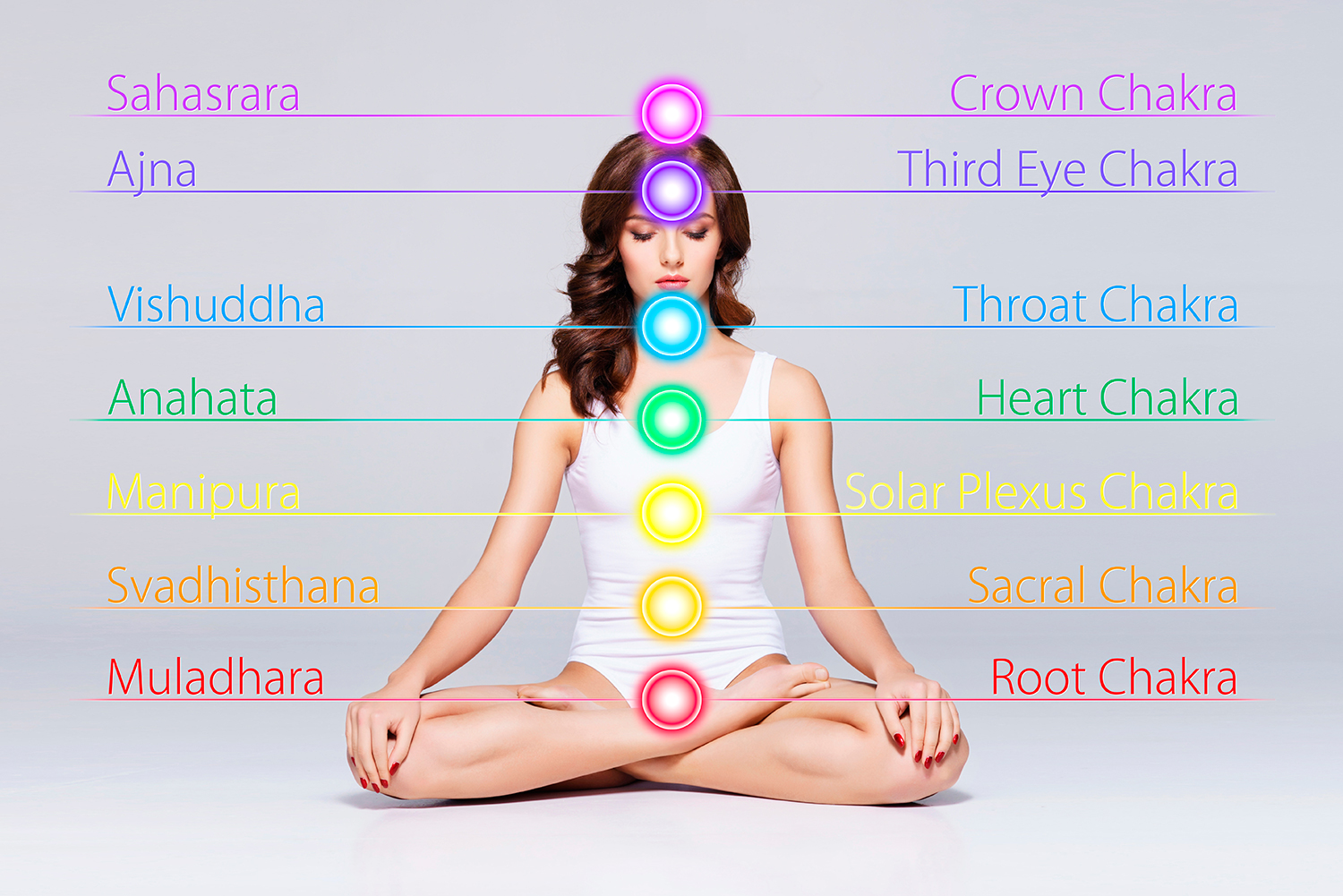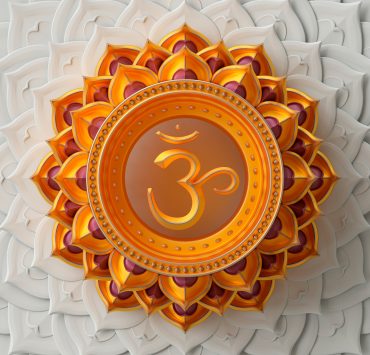
Having been a teacher’s assistant at over 50 yoga teacher…
Chakras as healing centers have been central to Hindu, Buddhist, and Eastern spiritual practices. These are focal points in the body that, when used with meditation, promote wellness.
“Chakra” translated from Sanskrit means wheel or circle. The body is a wheel of energy: how this wheel flows, connects, and interacts regulates the flow of energy. A balanced chakra system is tied to emotional processing, resistance to disease, and physical health.
Chakras can become misaligned, blocked, or exposed. Blocked energy can lead to illness or emotional pain. Therefore, chakra “balancing” can be used to restore energy and wellness.
There are 7 major chakras of the body. Each one is associated with a color, mantra (a word or sound repeated during meditation), and a place on the body. Together, yoga poses, meditation, and mindful nutrition, can be used to restore chakra alignment.
Chakra 1 — Root (Mooladhaara)

Color: Red
Location: Base of the spine in tailbone.
This chakra is closest to the earth, and is therefore associated with grounding and survival. In the body, it is connected with legs, feet, bones, and the colon. A balanced root chakra allows a person to feel safe, secure, and provided for.
Signs of over-activity: Paranoia, anxiety, fear based on the need to survive. Joint pain, digestive problems, low back pain, hip pain, swollen feet.
Signs of underactivity: difficulty concentrating, lack of energy or confidence, airheadedness. Foot and leg injuries, digestive problems, immune disorders.
How to balance your 1st chakra: Ensure that all basic survival needs are met. Beneficial practices include walking barefoot on the soil or grass; calming the spirit through prayer; reestablishing personal roots, and practicing grounded yoga poses.
Meditate: using the mantra Lam, or affirmations such as, I am grounded, I am safe, I am secure.
Yoga poses: Mountain, tree, warrior, side-angle, and bridge poses to aid in grounding.
Essential oils: Cedarwood, myrrh on wrists or lower back before sleep.
Supportive foods: Red-colored foods — red apples, beets, pomegranates, cranberry, radishes, red potatoes, red lentils. Root vegetables, mushrooms, animal proteins (meat, eggs).
Chakra 2 — Sacral (Swadhishtana)

Color: Orange
Location: Halfway point between the root chakra and the navel.
This chakra is associated with a sense of well-being, pleasure, and sexuality. In the body, the sacral chakra is tied to the lower abdomen, kidneys, bladder, circulatory system, and reproductive organs. A balanced sacral chakra promotes happiness, healthy relationships, creativity, a sense of harmony, and feeling satisfied.
Signs of over-activity: Obsessive behavior, lack of self-acceptance, emotional instability, sexual guilt, addiction, and restlessness. Constipation, back pain, infertility, or urinary tract infections.
Signs of underactivity: Loss of enjoyment in daily tasks. Depression, impotence, stunted creativity, lack of passion.
How to balance your 2nd chakra: Focus on activities that are nourishing for the heart and spirit—ask, “Is this good for me? Is this healthy and nourishing?” Healing this chakra involves nourishing the heart and taking joy in the simple things in life: food, partnership, sex, and hobbies. Be near water.
Meditate: with the word Vam, or affirmations such as I am healthy, I am creative, I am calm.
Yoga poses: Bridge pose, cobra pose, forward bend, sitting forward bend, bound angle pose.
Essential oils: Jasmine, sandalwood, rose, ylang ylang
Supportive foods: Oranges, tangerines, nuts, cumin, turmeric, ginger, orange-colored root vegetables (carrots, squash). Foods with a high water content, foods with vitamins A, B, and C.
Chakra 3 — Naval/Solar Plexus (Manipura)

Color: Yellow
Location: Above the naval, extends upward through the chest.
Glowing a bright yellow color, it is tied to feelings of confidence and control. A balanced naval chakra promotes feelings of worth, warmth, and trust in yourself and intuition. In the body: a healthy digestive tract, low stress, regular sleep, and balanced hormones.
Signs of over-activity: Short-tempered, controlling behaviors, greed, lack of compassion, inability to maintain eye contact. Digestive upset, overactive nervous system, adrenal fatigue, unhealthy sleep habits.
Signs of underactivity: Indecision, insecurity, neediness.
Healing the 3rd chakra: Meditation, breathing exercises, and doing slow yogic twists outside. Releasing stomach muscles.
Meditate: with the mantra Ram or affirmations such as I am worthy, I am confident, I am strong.
Yoga poses: Sun salutation, warrior, backbends, bow, half-twist, and boat poses.
Essential oils: Ginger, rosemary, or lemon
Supportive foods: Yellow-colored foods: corn, bananas, applesauce, grains, chamomile tea with lemon and ginger. Foods that promote digestive health: aloe juice, avocado, mint, kefir, yogurt, cinnamon, celery, and cucumber.
Chakra 4 — Heart (Anahata)

Color: Green
Location: Center of the chest, above the heart.
The heart chakra relates to love, compassion, calmness, and harmony. A balanced heart chakra manifests with a strong heart, immune system, and circulation. It is tied to feelings of love, kindness, compassion, and healthy choices.
Signs of over-activity: Feelings of isolation, loneliness, panic. Heartburn, anxiety, chest tension, shortness of breath, and elevated heartrate.
Signs of underactivity: Trust issues, inability to connect with others. Sadness, depression, poor circulation, breathing problems.
Healing the 4th chakra: Focus on deep breaths to clear the lungs, open the shoulders, and open the chest. Practice self-care activities to direct external love to yourself.
Meditate: with the mantra Yam or the affirmation I am compassionate, I am open.
Yoga poses: Chest-openers: camel, cobra, fish pose. Try this 30-minute yoga routine to open the heart chakra.
Essential oils: Rose, thyme
Supportive foods: Green, nutrient-rich vegetables: leafy greens, spinach, kale, cabbage, broccoli, dark lettuce. Alkalizing fruits and vegetables: green apples, limes, zucchini, celery, avocados, green beans.
Chakra 5 — Hroat (Vishudda)

Color: Blue
Location: Throat
Tied to the ability to communicate, self-expression, and speaking the truth. A balanced throat chakra means you can speak clearly with truth and kindness. Healthy glands, thyroid.
Signs of over-activity: Feeling ignored, invalidated, inability to speak the truth. Thyroid or hormone imbalances, throat pain, frequent infections, or ulcers.
Signs of underactivity: Shyness, inability to express your emotions.
Healing the 5th chakra: Speak with truthfulness and brevity. Practice expressing your emotions and truths, even alone. Being in or near water, walking under the sky, listening to sounds of water or wind.
Meditate: with the mantra Ham, or affirmations that promote strength and self-worth: I express myself truthfully and clearly, I am balanced.
Yoga poses: Fish, lion, or bridge poses. Neck stretches, shoulder openers, supported shoulder-stand, camel, and plow poses.
Essential oils: Eucalyptus, sage, blue chamomile
Supportive foods: Nutritional foods with a high water content, clear liquids and broths, herbal teas. Juices, fruits, and blueberries. Mineral water.
Chakra 6 — Third Eye (Anja)

Color: Indigo
Location: Center of the forehead, between the eyebrows.
This chakra is tied to contemplation, wisdom, decisiveness, and intuition. A balanced 6th chakra promotes a feeling of oneness, ease, and hearing your intuition. Associated with sound sleep and pituitary gland health.
Signs of over-activity: It is rare for people to suffer from an overactive Third Eye. Those that do may spend most of their time engrossed in psychic activities, such as paranormal experiences and astrological readings.
Signs of underactivity: Lack of foresight, mental instability, poor memory, feeling disconnected, judgmental behavior. Dizziness, blindness, tension headaches, depression, or sinus infections.
Healing the 6th chakra: Solitary meditation is the best practice for healing this chakra. As are simple repetitive activities, such as hiking or long walks outside. Visit natural landscapes that provide perspective.
Meditate: with the mantra Om or affirmations such as I am guided, I am centered, I am clear.
Yoga poses: Child’s pose, standing forward bend, humble warrior, warrior III, and seated meditation.
Essential oils: Sage, bay, or jasmine
Supportive foods: Raw nuts: almonds, walnuts. Purple-colored foods, such as: grapes, plums, goji berries, acai, eggplant, or blueberries. Detoxifying foods, such as: pineapple, mushrooms, grains, papaya, and cruciferous vegetables.
Chakra 7 — Crown (Sahasrara)

Color: Violet – White.
Location: On the crown of the head.
The crown chakra is associated with the connection to spirituality. A balanced crown chakra is tied to feelings of bliss and a healthy central nervous system. Calm, centered thoughts, and the ability to tap into a higher level of spirituality. This is the goal of every spiritual practitioner, and it is difficult to attain a fully balanced crown chakra.
Signs of over activity: Like the Buddhist principle of “nirvana,” it is not possible to have an overactive 7th chakra because it would mean one is no longer human.
Signs of underactivity: An underactive 7th chakra is normal: every human has an underactive 7th chakra. Signs include inability to concentrate, daydreaming, and not living in the present. Migraines, delusions, and stiff joints.
Healing the 7th chakra: Aligning this chakra is best done with meditation and balancing the other 6 chakras. Add daily outdoor walks to your routine, focus on being present, and cultivate gratitude.
Meditation: recommended without a mantra. Use affirmations such as I am present, I am here, I am connected.
Yoga poses: Balancing poses that bring awareness to the body: tree, mountain, and eagle poses.
Essential oils: sandalwood, geranium, myrrh
Supportive foods: Water absorbed through the skin; sesame or chia seeds; bone broth, topical essential oils, and aloe vera juice.
Because this chakra is tied to the spiritual, the crown chakra is most likely to benefit from sun, fresh air, and quiet meditation.
What's Your Reaction?
Having been a teacher’s assistant at over 50 yoga teacher trainings worldwide, Rebecca Rebecca has a firm grasp on the fine art of yoga and meditation. In her work, she carefully reflects on a vast expanse of knowledge to help others find peace in both body and mind.














